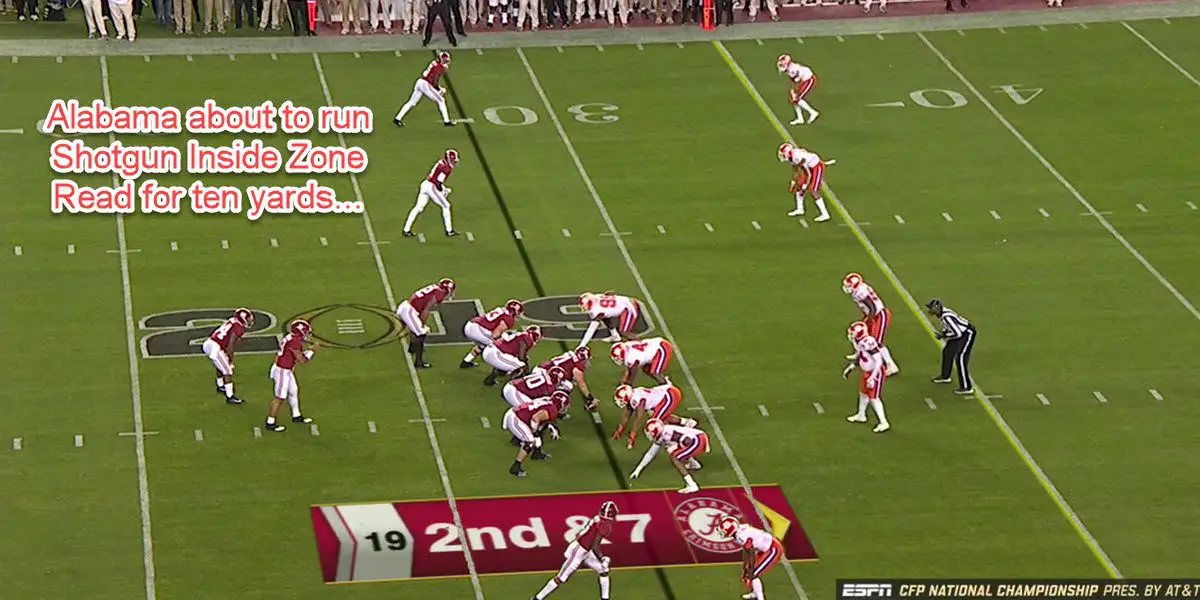The question I’ve posed aloud numerous times on this site for the current coaching staff at Oregon that has never been answered is a big one …
“When the Oregon Spread Offense under Chip Kelly/Mark Helfrich from 2008 through 2016 averaged nearly 43 points a game, (42.8) and it became the brand of Oregon football and what we were known for … why would you change it?”
I have pondered this often and have come up with a few reasons we will discuss below, but I also wanted to examine further what the Oregon offense was moving to, and compare it to what we were used to under Kelly/Helfrich. I took a look at the offenses, and in particular the running plays of Alabama and Clemson in each of their last three games (the most important of the season and likely to have less garbage time) and compared them to what I know of the Original Oregon Spread Offense under Kelly/Helfrich in an attempt to answer some questions. The conclusions surprised me, and perhaps it will give us all some discussion points and elements to watch for in the coming season.
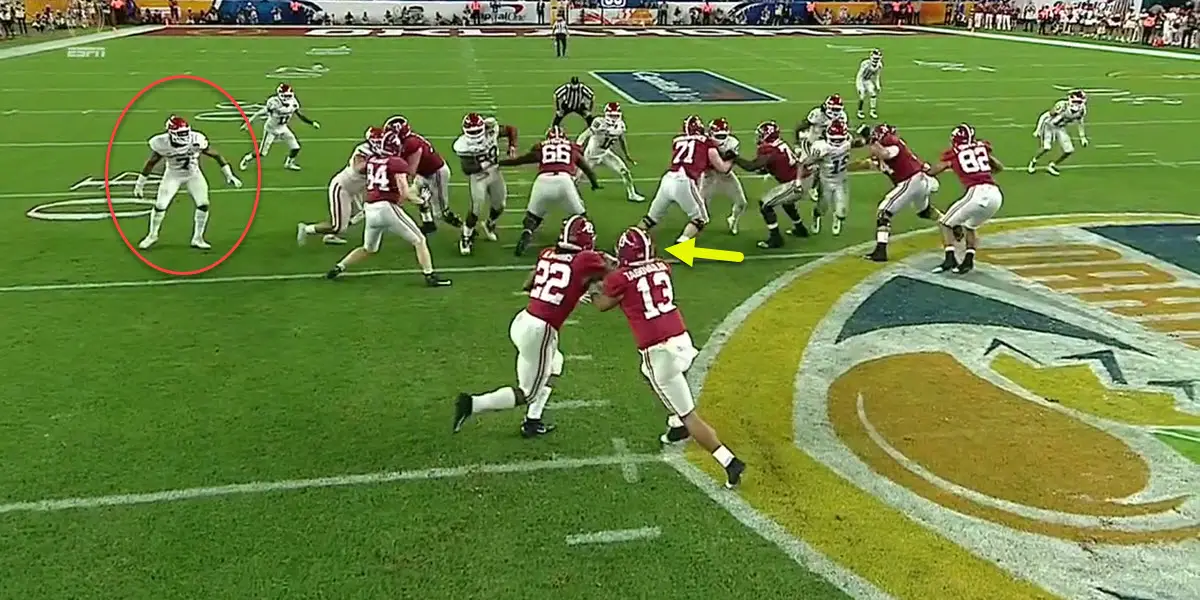
Alabama running an Outside Zone Read from the Shotgun with the read-key on the backside of the play.
It is important to define that when I refer to the Shotgun formation … this is when the running back is to the side of the quarterback as if he was riding “shotgun,” hence the origin of the formation name. The Ducks used this formation almost exclusively during the Golden Era of the Oregon Offense, and I have been told by many on this and other sites to “give it up,” as Oregon is never going back to the Chip Kelly days.
Why not? Why not build a great defense and score boatloads of points?
I began to consider how the Alabama offense might be all that head coach Mario Cristobal knows, but not all that Offensive Coordinator Marcus Arroyo knows. Perhaps it is the New England Patriot way of winning? This is propounded on one Oregon site, and it was suggested by legendary coach Tony DeMeo in a recent FishDuck.com article. The objective is to control the ball and work the clock; play great defense with superb special teams play, while running the ball well.
That sounds great in theory, but in reality — how many times did one of the greatest quarterbacks of all-time (Tom Brady) bail out the Patriots at the last minute? Wasn’t the New England offense dependent upon a strong passing game as well? And it never hurts to have an incredible quarterback …
I am leery of adopting that line of reasoning for why Oregon is abandoning the Original Oregon Spread Offense. Another component is how the defensive talent level at Alabama and Clemson are stunning, and yet they get scored on quite a bit by their opponents. You still must score a ton of points to win the ultimate prize in college football, in my humble opinion.
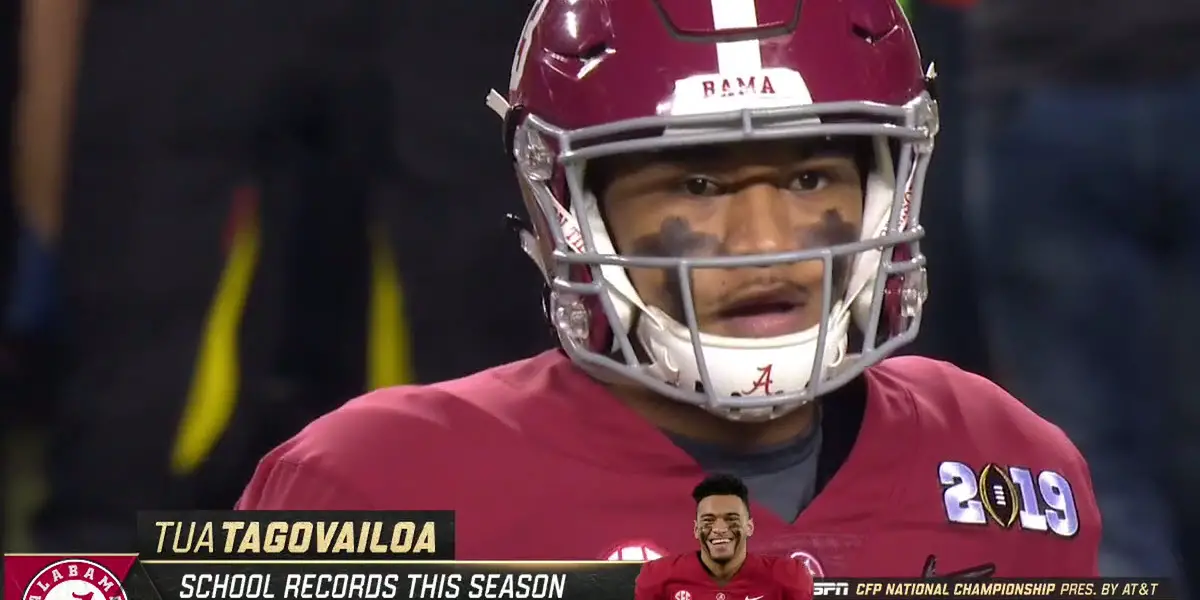
At the very top of college football are sophisticated passing attacks scoring a ton of points.
So Then WHY Did Cristobal Change the Offense, Mr. FishDuck?
I was actually contemplating whether it was a “pride thing” with Cristobal … that he did not want pundits gossiping after the fact that he just took what Kelly built, recruited a bit better, upgraded the defense and won off the coattails of prior coaches. Hence, he ditched the Original Oregon Spread Offense and created his own hybrid offense that he could put his own label on.
That made sense on an emotional level, but I believe Cristobal is a very smart fellow, and above that kind of pettiness. Now, I had to dig into the offenses of Alabama and Clemson (the Oregon staff visited both this last spring) and look at the Pistol versus the Shotgun formation usage and compare those notes to what I know of the Original Oregon Spread Offense. I did not expect what I was about to learn …
The Clemson Offense Looks Familiar …
As I charted the running plays of the Tigers, I was surprised to see that they ran the Shotgun formation for running plays 88% of the time! The Pistol was used to mix it up (12% of the time), and when sparsely used, it averaged more yards per running play (6.10 yards) than those from the Shotgun (5.81 yards). These stats were taken before the major garbage times at the end of games — when the running yards mattered.
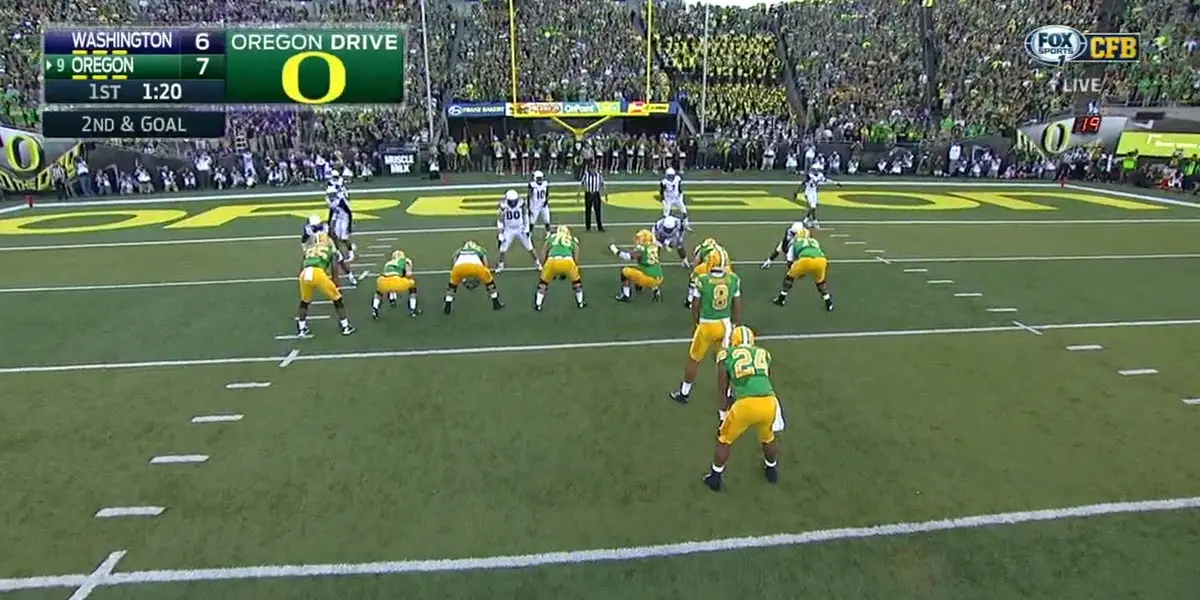
Oregon putting the short Pistol or Derringer into the ribs of the damn Huskies in 2014.
What surprised me the most was when Clemson went to a Pistol, it was the short Pistol like Oregon began using in 2014! We called it the Derringer, and it was a great change-up to throw at defenses, on occasion. The offensive line of the Tigers was incredibly impressive, as they just blew opponents out — even the Crimson Tide when it counted. In fact, as I watched Clemson run the Zone Read with the Shotgun and the short Pistol formations complemented by a skillful quarterback and fleet receivers, it looked just like the 2014 Oregon Offense!
FishDuck.com writer, Greybeard, and Duck-Buddy Brent Pennington grew up in Oregon, but lives in Greenville, South Carolina and knows the Tigers well. He explained that after Dabo Swinney went 6-7 in 2010, new Clemson Offensive Coordinator Chad Morris went to Eugene, Oregon to huddle with the Ducks, hence why their offense looks so familiar. If someone tells me to give up the Chip Kelly offense and adopt the Clemson offense — it would be quite the Back-to-the-Future moment for me.
The talented QB for Clemson, Trevor Lawrence, is 6’6″ and has adequate, but not blinding speed, while the focus of his game is directing a pin-point passing attack. Does that physical profile sound familiar to Oregon fans? Perhaps the game-plan for Cristobal’s QB recruiting is making more sense to some of us?
If you want to convert to the Clemson offense — count me in …
How Difficult Is a Conversion to the Crimson Tide Offense Going to Be?
I was taken aback by how often Alabama ran the same Shotgun Inside Zone-Read plays that we were accustomed to under Kelly. Not only did the ‘Tide make the read-key on the backside of the play, but on occasion they would mix it up and read the defensive end on the playside of Outside Zone Read plays, which blew my mind. I did not think Nick Saban would ever become that aggressive and frankly — expose Tua Tagovailoa to injury with such a play selection. The Crimson Tide ran the Shotgun 78% of the time with their running plays and averaged 6.15 yards, while running the Pistol 22% of the time for a respectable 5.33 yard average.
Keep in mind that Alabama will also run twin-back sets, a Wildcat or two and even snap under center inside the five-yard line (which I love). Thus, the Tide has a diverse offense, and again, I am simply comparing the number of running plays that were run out of the Shotgun and the Pistol, and determining how successful the offense was from either formation.
Alabama likes to run the Pistol formation with a deeper running back placement as Oregon is currently doing, and like Clemson, they prefer to have a balance of great passing complemented by a powerful running attack. Is that so different from what we were used to seeing in the Golden Era?
When you consider that the Shotgun is used the vast majority of the time by Alabama, and how they want to put up loads of points through the air, this would be a high-scoring and fun replacement to the Original Oregon Spread Offense.
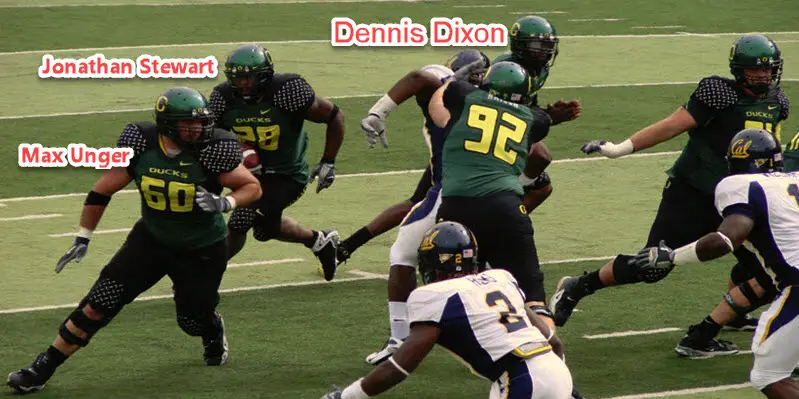
Jonathon Stewart following Max Unger.
There Is ONE Key Difference to Be Aware of
Both Clemson and Alabama have huge offensive linemen that do not leave the box; they pull for counters and power plays, but it is only to the other side of the box and a very short journey. The days of Max Unger or Hroniss Grasu beating running backs Jonathan Stewart or LaMichael James to the perimeter from the center position are truly gone.
The new recruiting profile calls for larger, powerful linemen who can move, but are not meant for downfield blocking. Outside Zones and Sweeps have the blocking done by the receivers, Tight Ends/H-backs and running backs in the Alabama/Clemson versions, and not pulling linemen as we had at Oregon in the past. Thus, we now understand why the new recruiting profile for offensive linemen for the Ducks puts less premium on speed, and more upon power and bulk.
Can Oregon Be Scoring Scads of Points Again?
The short answer is yes, and here is why:
In the latter part of the 2017 season, as Herbert came back from injury — we witnessed a combo offense mixing the Original Oregon Spread Offense with the Shotgun, the Pistol and NFL/Alabama-style plays from Cristobal and some components of the Willie Taggart Gulf Coast Offense. Oregon piled on points as the variety of attacks kept opponents off-guard, and I personally liked that combo offense even more than the Kelly/Helfrich version we evolved from.
I believe the Oregon offense can return to that combo attack, and it will be fun to see if that is what has been hinted in changes to the offense for the 2019 campaign.
There is another reason that Oregon can be scoring significantly again that I initially rejected, but have now come around to — thanks to the patient drip-drip approach of fellow Greybeard and superb commenter, Platypus. He has stated that Oregon’s 34.8 point per game scoring average in 2018 could increase another eight points per game this year (to duplicate the 42.8 points per game of the Golden Era), as the players are getting acclimated to the new offense and the receivers catch the ball more often. After watching Alabama and Clemson … I am inclined to now agree with my frequent-opponent-and-always-friend in the comments on this site. It is attainable …
This is why I want to hear all views in the comments below articles … especially the ones that disagree with me and the majority view. We need the wisdom of the thousands of readers who come here, and as long as you post while following our rules, (which is simply insisting on being nice to each other) the result will be vigorous debate that we all enjoy and learn from. We want to hear from all of you!
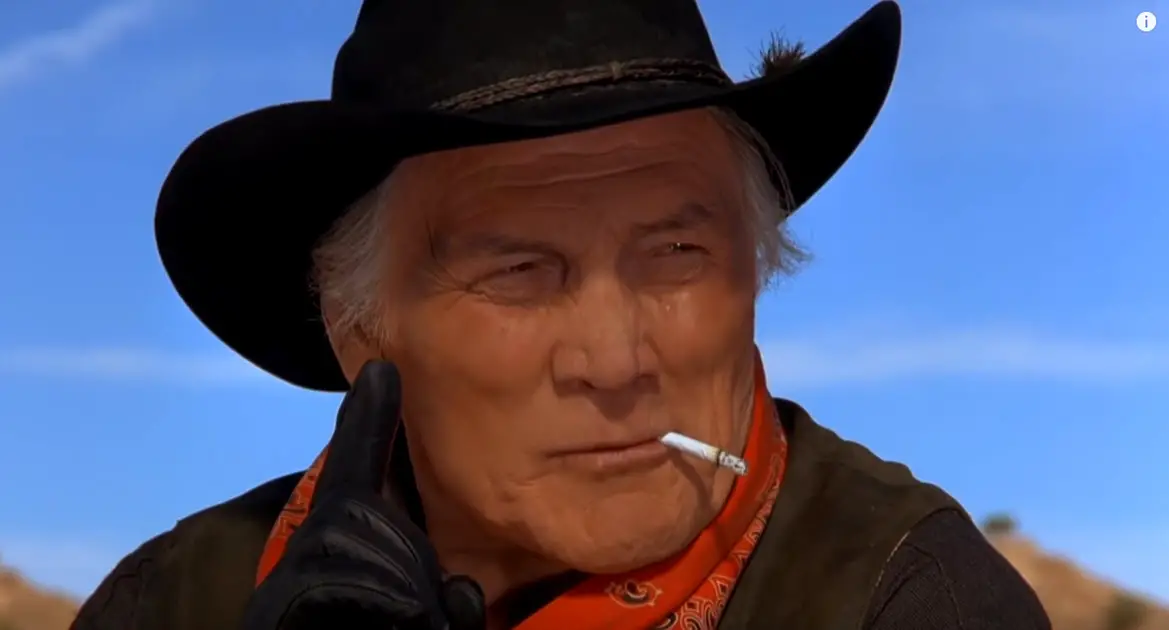
Jack Palance knows the “one-thing” for the Oregon Offense …
What Is the ONE THING That Determines the Offensive Success This Fall?
There is no doubt that the new offense can work from an Xs and Os standpoint in 2019, since so much of the offense is the Shotgun of the Golden Era. The real question is whether this offensive coaching staff can pull it off?
Now that my friends is what is going to be high drama and very entertaining to follow. We will discuss it all here as it unfolds!
“Oh how we love to ponder about our Beloved Ducks!”
Charles Fischer (FishDuck)
Eugene, Oregon Top Photo From Video

Chris Brouilette, the FishDuck.com Volunteer editor for this article, is a current student at the University of Oregon from Sterling, Illinois.
Related Articles:
Oregon Enters Playoffs Better Off Than Last Year
Will The Coaching Carousel Kill Oregon's CFP Chances?
The Playoff Formula Hasn't Changed
Oregon Aims to Bury Dawgs, Punch Playoff Ticket in Rivalry Clash
Huskies Are the New Beavers, Stay In Your Lane Kiffin, and the Civil Apple Cup War
Oregon Football: The X-Factor Vs. Washington

Charles Fischer has been an intense fan of the Ducks, a season ticket holder at Autzen Stadium for 38 years and has written reports on football boards for over 26 years. Known as “FishDuck” on those boards, he is acknowledged for providing intense detail in his scrimmage reports, and in his Xs and Os play analyses. He is single, has a daughter Christine, and resides in Eugene Oregon where he was a Financial Advisor for 36 years.
He now focuses full-time on Charitable Planned Giving Workshops for churches and non-profit organizations in addition to managing his two Oregon Football Websites, of FishDuck.com and the Our Beloved Ducks forum. He is a busy man!
He does not profess to be a coach or analyst, but simply a “hack” that enjoys sharing what he has learned and invites others to correct or add to this body of Oregon Football! See More…

